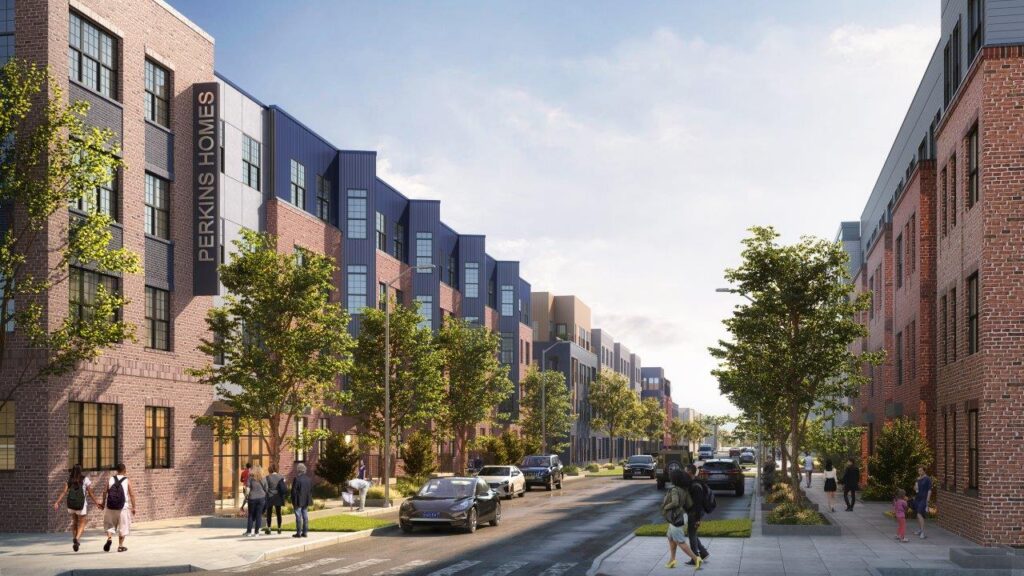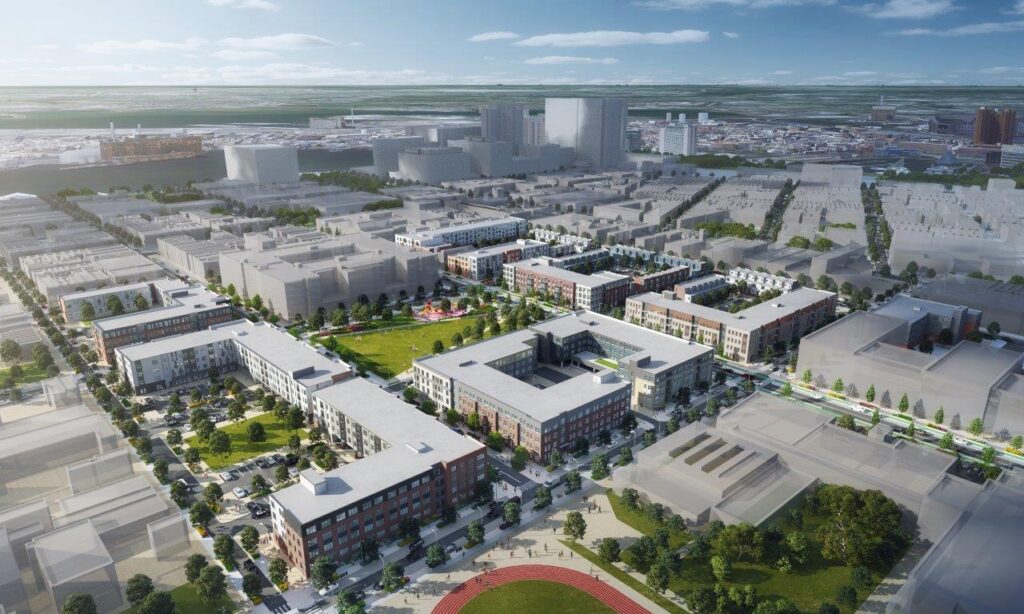Replacing and Preserving Affordable Housing Amidst Urban Revitalization
The Perkins Homes Redevelopment – A“Choice Neighborhood”

By Ethan Finlan
7 min read

Since 2018, the City of Baltimore, the Housing Authority of Baltimore City (HABC), planners, architects and developers have been working on a comprehensive redevelopment of a large public housing project near the city’s famous Inner Harbor. The redevelopment initiative utilizes a Department of Housing and Urban Development funding source aimed at helping communities revitalize while maintaining affordable housing stock and preventing displacement.
Project History
The Perkins Homes complex once housed 629 public housing apartment units but by the 2010s the complex had fallen into disrepair, along with another shuttered public housing facility, Somerset, and a shuttered outdoor mall. “This footprint had been historically underserved and suffered from years of disinvestment,” says Ingrid Antonio, HABC’s senior vice president of communications.
In 2014, HABC and the City began evaluating revitalization options for the Perkins Somerset Oldtown neighborhood (PSO), partnering with EJP Consulting and a multi-disciplinary design firm Hord Coplan Macht (HCM). Planning started in 2015, says HCM Associate Principal Matthew Fitzsimmons. Following a delay in the project, a new team, including McCormack Baron Salazar (MBS), Beatty Development, Commercial Construction Group was formed, successfully attracting $540 million in private financing and then a $30 million HUD grant. Allyson Carpenter with MBS credits Charm City’s “vibrant resurgence” and the “exceptional leadership” of Janet Abraham with attracting the firm.
The teardown started in 2021, with residents given first right to the replacement units upon their completion. To provide a smooth transition for residents, the project was planned in phases, Fitzsimmons says, to build new homes first on unbuilt land. The PSO redevelopment will include around 1,435 units, the majority of which will be on or near the Perkins complex, consisting of “48.5 percent subsidized units [and] 20.5 percent additional affordable units (LlHTC),” states a HABC report. Included in the redevelopment are two parks, a new school, a grocery and aesthetic improvements to existing buildings. A HUD spokesperson notes that social services for tenants aimed at increasing income are also part of the project’s scope.
Financing
The $30 million came from HUD’s Choice Neighborhoods program, whose goal is to finance the redevelopment of severely distressed HUD public housing or other HUD Multifamily housing, provide supportive services for housing residents, as well as fund neighborhood “physical improvements, which attract private investment, spur economic development and improve amenities and services for residents.” Goals for residents include better “employment, health and education outcomes” and opportunities to increase residents’ incomes.
According to HUD’s Luci Blackburn, the program started in 2010, as a “successor” to HUD’s HOPE VI initiative. HOPE VI repaired dilapidated public housing units and funded social services for tenants, Blackburn says, but its scope was limited. “There was a question of ‘how successful could your housing be if you didn’t address the neighborhoods around the housing?’”
Municipalities, housing authorities and tribes can apply, and applicants are scored based on a variety of metrics, Blackburn says, like leverage funding and redevelopment plan details. Projects must be in neighborhoods with at least 15 percent of residents being below poverty or “extremely low-income.” Applicants must have completed a comprehensive Neighborhood “Transformation” Plan, which meets Choice Neighborhoods goals and includes a Housing Plan for redevelopment of the targeted HUD-assisted housing project. New units must be mixed-income, providing units that accommodate families from a broad range of income levels, including families at 80 percent of area median income or lower, and units with no income restrictions. Units must meet environmental and accessibility goals and aim to decrease vacancy levels. And residents whose units are demolished during redevelopment must be offered the first right to return to replacement units. HUD’s spokesperson says approximately 70 percent of a grant pays for housing redevelopment, 15 percent for neighborhood improvements and 15 percent for resident services.
Program grantees must meet data reporting mandates, and HUD representatives meet regularly with project participants and visit projects themselves. “We are a hands-on program,” Blackburn says, adding, “We consider ourselves partners, not just monitors.”
Blackburn and HUD’s spokesperson credited Baltimore’s strong partnership with private developers and success in attracting private funding for the Perkins Homes project’s high score. The project received funds from a tax increment financing (TIF) program, the spokesperson says. Typically, TIF programs provide funding from government bodies that are effectively paid back through future tax revenue. According to Antonio at HABC, the equity funding came from Berkadia and RBC, while Bank of America and M&T provided construction loans.
The State of Maryland’s involvement also helped. “There is no way you can do this work without a committed partner at the state level,” the HUD spokesperson says, because states supply LIHTC allocations. (The 2020 NOFA notes that four and nine percent LIHTC allocations, and other tax credits, count towards leverage factors if allocated at the time of application.)
“Our goals are to improve the housing, to assist the residents to improve their lives and to spur economic developments in the neighborhoods,” Blackburn says. With the Perkins Homes, HUD “[sees] really strong evidence of meeting [the] goals of the program.”
The grant attracted further funding. “It allowed us and our development partners…to attract over $1 billion in additional investment across PSO from like-minded partners,” writes Antonio. HUD’s spokesperson notes that Choice Neighborhoods grants help attract private debt to help finance projects.

Design
Design considerations were key to the project, stresses Fitzsimmons and colleague Keval Thakkar, HCM’s principal on the project. HCM’s website states that the project develops “an inviting landscape experience while balancing the needs of people, bikes, cars, transit and vital ecological functions.”
“The idea was always to give this place a fresh start,” emphasizes Thakkar, moving away from the older “barrack style building” architectural theme and isolated nature of the buildings. “They were all inward-looking,” Thakkar says. Fitzsimmons notes that some project materials and design aspects nonetheless harkened back to the neighborhoods’ “industrial heritage.” To accommodate family size, some units have up to six bedrooms.
Architects took measures to construct inviting buildings, including using a lighter cream-colored brick in contrast to the red brick used on the now demolished Perkins Homes buildings. “None of it should look like affordable housing,” Thakkar emphasizes. “It should all blend in.” This informed window design also “provided economies of scale.” Standard-size windows were arranged to create an interesting pattern and variation to not make it look repetitive and uninviting. Parking was limited, thanks to the parcels’ proximity to mass transit. One street was redesigned as a bicycle, pedestrian and transit thoroughfare.
Partners launched a robust public outreach process, which informed the decision to build outward-facing buildings. The process included over 500 public meetings, Antonio reports. As a result of community feedback, the project includes three-bedroom townhomes, a new pedestrian path, improved amenities like closet space in the units themselves, internet access in the common area and “intergenerational park equipment play equipment that serves residents with learning disabilities, a great lawn area to facilitate community movie nights, monument area and amphitheater.”
***
The partners unanimously viewed Choice Neighborhoods grants as promising funding sources for affordable projects, both in Maryland and nationwide. In 2022 and 2023, the program received $350 million from Congress, Blackburn says. Over the life of the program, more than $1 billion has been awarded, generating more than 30,000 units nationwide. Fitzsimmons stresses that such funding can allow for better lives for residents, and “make a better, healthier, happier neighborhood” by financing improvements, like streetscapes. MBS has participated in 17 Choice Neighborhoods projects, Carpenter says. Antonio calls Choice Neighborhoods grants an “important tool in redeveloping our affordable housing portfolio.”
The grant program has been instrumental to Perkins Homes’ success, and officials and community leaders are optimistic. Denise Street, the president of the Perkins Homes Tenant Council, stated, “I look forward to coming home and making sure that [Perkins’] returning residents can see the promises that HABC delivered on.”